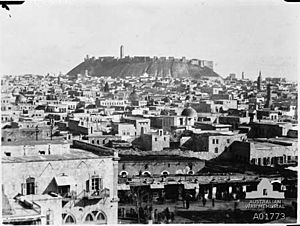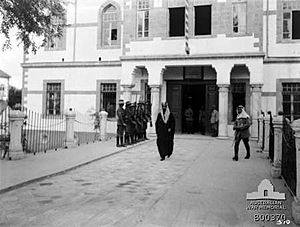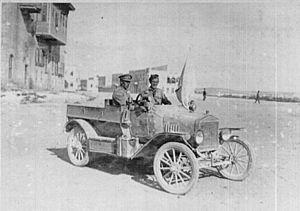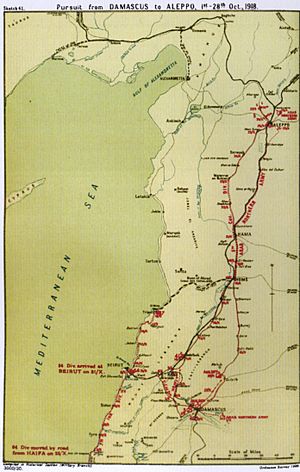Battle of Aleppo (1918) facts for kids
Quick facts for kids Battle of Aleppo (1918) |
|||||||
|---|---|---|---|---|---|---|---|
| Part of the Middle Eastern theatre of World War I | |||||||
 Aleppo c. 1918 with the Citadel in the background |
|||||||
|
|||||||
| Belligerents | |||||||
|
|
|||||||
| Commanders and leaders | |||||||
| Strength | |||||||
| Sherif Nasir and Nuri Bey's Forces | Remnants of the Yildirim Army Group | ||||||
The Battle of Aleppo happened on October 25, 1918. It was a key moment in the final days of World War I in the Middle East. During this battle, forces led by Prince Faisal captured the city of Aleppo.
This battle was part of a larger push by the British Empire and their allies. After a big victory at the Battle of Megiddo, the remaining forces of the Ottoman Empire were retreating. Prince Faisal's Arab forces chased them, capturing Deraa on September 27. Other Allied forces, including Australian and Indian cavalry, also chased the Ottomans. They captured Damascus on October 1, 1918. Thousands of German and Ottoman soldiers were captured.
Some Ottoman forces managed to escape Damascus. They regrouped and then retreated through Homs and Hama towards Aleppo. The Allied forces, especially the Desert Mounted Corps, faced challenges like sickness. This slowed down their chase from Damascus. However, armored cars and light car patrols, supported by cavalry, continued the pursuit.
Prince Faisal's forces, who had been protecting the right side of the advance, continued north. They followed the Hejaz railway and reached Aleppo. They attacked Ottoman defenses south of the city. Then, under the cover of darkness, they moved around these defenses. They entered Aleppo, where intense street fighting lasted most of the night. By morning, the city was under the control of Prince Faisal's forces.
Contents
Why Aleppo Was Important
After the big success at the Battle of Megiddo, British leaders wanted to keep pushing. They thought the Egyptian Expeditionary Force (EEF) could even reach Aleppo. This was a very ambitious idea.
By October 1, about 19,000 Ottoman soldiers had retreated north. Only about 4,000 of them were still able to fight. Their commander, Liman von Sanders, moved his headquarters back. He ordered his remaining forces to gather at Rayak. Many Ottoman units were in disarray. Only a few German and Ottoman regiments remained organized.
The Allied cavalry, the Desert Mounted Corps, was already 150 miles (240 km) from its main supply base in Damascus. Aleppo was another 200 miles (320 km) further away. General Allenby, the Allied commander, wanted to advance carefully. He knew that supplying his troops over such long distances would be difficult. He estimated there were about 25,000 enemy troops in the Aleppo area.
Aleppo is a very old city, known as Halab since ancient times. It had been captured by Arabs in 646 and later by the Ottoman Empire in 1516. By 1918, it had about 150,000 people. Aleppo was important because it was near a key railway junction. This junction connected the railway systems of Palestine and Mesopotamia.
Getting Ready for Battle
Liman von Sanders ordered Mustafa Kemal, a famous Ottoman general, to defend Aleppo. Liman von Sanders himself moved his German troops further north. He didn't expect to hold much land south of the Taurus Mountains.
Allied Forces
The Allied forces chasing the Ottomans included Prince Faisal's Arab forces. These were two groups of 1,500 soldiers each. One was led by Colonel Nuri Bey, and the other by Sherif Nasir.
There were also 24 armored cars and light car patrols. These vehicles were armed with machine guns. The 5th Cavalry Division's 15th Imperial Service Cavalry Brigade supported the armored cars. The rest of the division followed behind.
The 5th Cavalry Division and the armored cars were split into two groups. Group "A" had the division's headquarters, all the armored cars, and the 15th Imperial Service Cavalry Brigade. Group "B" had the 13th and 14th Cavalry Brigades.
Ottoman Defenses
Aleppo was defended by about 4,000 Ottoman soldiers. There were also about 20,000 people in the city and nearby. Mustafa Kemal and Nehed Pasha, commander of the Second Army, organized these forces. They set up their headquarters at Katma.
Mustafa Kemal placed four divisions south of Aleppo. These included the newly formed 1st and 11th Divisions. They had between 2,000 and 3,000 soldiers each. The 24th and 43rd Divisions also held strong defensive positions.
Mustafa Kemal also sent the 41st Division to defend Alexandretta. This was northwest of Aleppo. Other divisions were in reserve further north. All the remaining German troops had been pulled back. They were gathered near Tarsus. Many other Ottoman armies had been destroyed or scattered.
Armored Car Scouting Mission
The speed of the chase depended on fuel for the cars and food for the horses. Airplanes flew ahead to find enemy forces.
On October 23, a group of armored cars scouted towards Aleppo. They left the 15th Imperial Service Cavalry Brigade behind. They attacked some enemy cavalry south of Aleppo. Then they met 2,000 to 3,000 Ottoman infantry soldiers. These soldiers were dug in about 3 miles (4.8 km) south of the city. Air and ground scouting showed that 6,000 to 7,000 more soldiers were in Aleppo.
Major General H. J. Macandrew, leading the 5th Cavalry Division, sent Captain R. H. M. McIntyre with a white flag. He demanded Aleppo's surrender, but Mustafa Kemal refused. The armored cars then tried to find a way around the rocky hills. They were looking for a path to the Alexandretta road. But the land was too rough for the cars. They pulled back to Khan Tuman for the night.
The Battle for Aleppo
While the armored cars waited for more troops, they kept checking the Ottoman defenses. Prince Faisal's Arab forces, led by Nuri Bey, moved along the Hejaz railway. On October 25, Nuri Bey attacked the Ottoman positions south of Aleppo. However, the Arab forces were pushed back by heavy fire.
Nuri Bey's forces were then joined by another group of 1,500 Arab soldiers. These were led by Sherif Nasir. Prince Faisal had ordered them to advance from Homs to Aleppo. Meanwhile, the 15th Imperial Service Cavalry Brigade met up with the armored cars. They were about 13 miles (21 km) southwest of Aleppo.
General Macandrew planned a three-sided attack on the city for October 26. The armored cars would attack from the south. Prince Faisal's forces would attack from the east. The 15th Imperial Service Cavalry Brigade would move west of Aleppo to cut the Alexandretta road.
However, during the night of October 25, Nuri Bey's Arab forces attacked the city from the east. Sherif Nasir's Arab forces moved around the Ottoman defenses. They entered the city and connected with their supporters inside.
Hand-to-hand fighting broke out in the streets during the night. In the confusion, Mustafa Kemal moved his headquarters out of the city. He lost contact with his forces defending south of Aleppo. By the morning of October 26, these defenses were empty. Aleppo was captured by Prince Faisal's forces by 10:00 AM on October 26. They had 60 soldiers killed. General Macandrew arrived shortly after with the armored cars.
What Happened Next
Part of General Macandrew's planned attack still happened. At 7:00 AM on October 26, two cavalry regiments advanced to the Alexandretta road. They continued to Haritan, where they charged an Ottoman rearguard twice. But the Ottomans fought back strongly, forcing the cavalry to retreat. The Ottoman forces also retreated. They set up a new defensive line further north.
The remaining Ottoman forces were now trying to defend what was left of their empire. Mustafa Kemal's Seventh Army, which had escaped earlier battles, was north and northwest of Aleppo. The Second Army, with about 16,000 soldiers, was to the west. The Sixth Army, with another 16,000 soldiers, was to the northeast.
There is a cemetery in Aleppo for British and Commonwealth soldiers from World War I and II. It is located near Sheikh Maqsoud. This cemetery has been maintained, even after the Syrian civil war.
Images for kids





